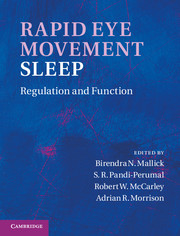Book contents
- Frontmatter
- Contents
- Contributors
- Preface
- Acknowledgments
- Organization
- Section I Historical context
- 1 The sleep–dream state: historic and philosophic perspectives
- 2 REM sleep and dreaming
- 3 REM sleep and dream sleep: are they identical?
- 4 The discovery of REM sleep: the death knell of the passive theory of sleep
- 5 REM sleep and dreaming: the nature of the relationship
- Section II General biology
- Section III Neuronal regulation
- Section IV Neuroanatomy and neurochemistry
- Section V Functional significance
- Section VI Disturbance in the REM sleep-generating mechanism
- Index
- Plate section
- References
2 - REM sleep and dreaming
from Section I - Historical context
Published online by Cambridge University Press: 07 September 2011
- Frontmatter
- Contents
- Contributors
- Preface
- Acknowledgments
- Organization
- Section I Historical context
- 1 The sleep–dream state: historic and philosophic perspectives
- 2 REM sleep and dreaming
- 3 REM sleep and dream sleep: are they identical?
- 4 The discovery of REM sleep: the death knell of the passive theory of sleep
- 5 REM sleep and dreaming: the nature of the relationship
- Section II General biology
- Section III Neuronal regulation
- Section IV Neuroanatomy and neurochemistry
- Section V Functional significance
- Section VI Disturbance in the REM sleep-generating mechanism
- Index
- Plate section
- References
Summary
Summary
Among sleep stages, awakenings from rapid eye movement (REM) sleep produce the greatest number and reported intensity of dream reports. Dreaming is a conscious state that lacks the insight and cognitive control typical of healthy waking but allows the remarkable emergence of coherent narrative, vivid visual imagery, strong emotion, and sometimes never-before-experienced elements. Similar to waking, ascending activation from the brain stem, basal forebrain, and diencephalon produces the brain-activated state of REM and its associated dream consciousness. However, in REM, the neuromodulatory influences producing this arousal are largely cholinergic and lack the aminergic activation accompanying cholinergic modulation in waking. Positron emission tomography (PET) studies have shown that in REM vs. waking, lateral cortical areas subserving cognitive control and higher order cognition are relatively less activated whereas midline anterior limbic cortical and subcortical structures are equally or more active. Such differences in neuromodulation and regional brain activity help shed light on the neural processes producing phenomenological differences between dream and waking consciousness. Advances in neuroimaging techniques including functional magnetic resonance imaging (fMRI) and electromagnetic source localization are providing new details on the tonic conditions and phasic neural events during REM that may contribute to dream experience.
- Type
- Chapter
- Information
- Rapid Eye Movement SleepRegulation and Function, pp. 8 - 20Publisher: Cambridge University PressPrint publication year: 2011

